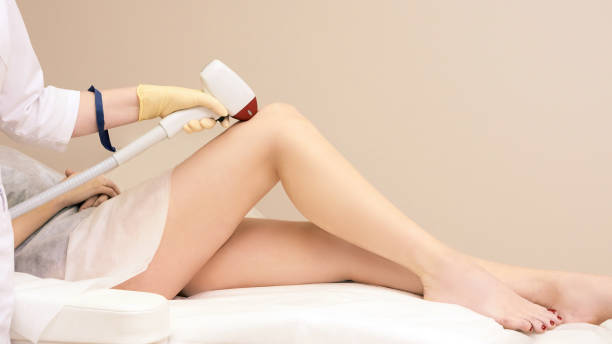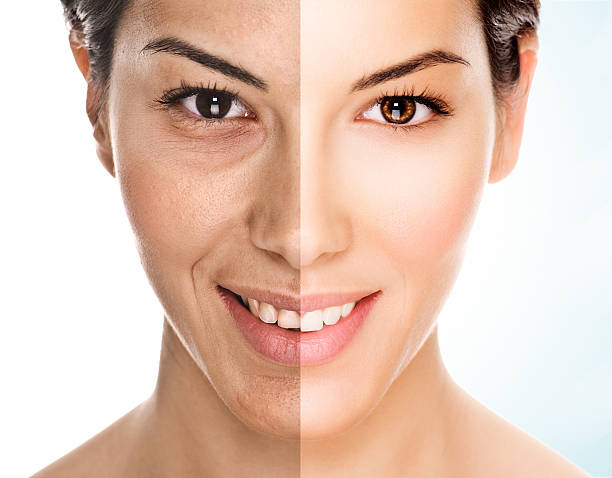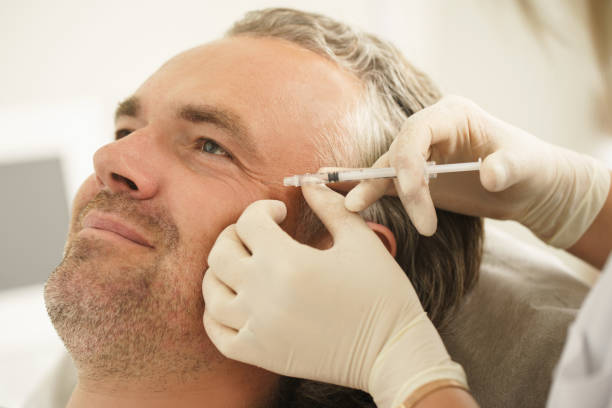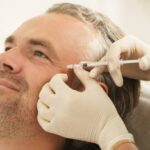
by enfieldroyalsaudi049 | Jul 16, 2025 | Health
Laser hair removal has become a popular and effective solution for long-term hair reduction. However, when it comes to sensitive areas of the body—such as the bikini line, underarms, face, and neck—special care is required to ensure safety and comfort. This blog will guide you through essential tips and precautions for laser hair removal on delicate skin, helping you make an informed and confident decision.
What Makes Laser Hair Removal on Sensitive Areas Different?
Sensitive areas have thinner skin and more nerve endings, making them prone to irritation, redness, and discomfort during and after treatment. Moreover, these regions often have unique contours and skin characteristics, which require customized treatment settings and professional expertise. The goal is to achieve effective hair removal while protecting the delicate skin and minimizing side effects.
Laser Hair Removal in Riyadh is popular for treating sensitive areas due to the availability of experienced professionals who use advanced technology adapted for safety and precision in these zones. Choosing the right provider and understanding the process can make your experience both safe and comfortable.

How Laser Hair Removal Works on Sensitive Skin
Laser hair removal targets the pigment (melanin) in hair follicles using concentrated light energy. This energy heats and disables the follicle, preventing future hair growth. In sensitive areas, the laser’s intensity is adjusted specifically to avoid damaging surrounding tissues, and cooling techniques are often used to soothe the skin during treatment.
Customized Technology for Sensitive Zones
-
Lower energy settings to reduce discomfort and skin damage risk
-
Use of cooling devices or gels to minimize heat sensation
-
Smaller or more precise laser applicators for targeted treatment
Such adaptations ensure that sensitive skin areas, like the upper lip, bikini line, or underarms, receive effective care without compromising safety.
Preparing for Laser Hair Removal on Sensitive Areas
Proper preparation is crucial to reduce the risk of side effects and improve treatment results. Here are key steps to prepare your skin before your session:
Avoid Plucking, Waxing, or Bleaching
Hair follicles must be intact for laser energy to target them effectively. Removing hair by plucking or waxing before treatment can reduce effectiveness. Shaving is recommended instead.
Shave 24 Hours Before Treatment
Shaving the area about 24 hours prior to your appointment clears surface hair without damaging the follicle and reduces the chance of skin irritation.
Keep Skin Clean and Free of Products
Avoid applying lotions, deodorants, makeup, or perfumes on the treatment day. Clean skin helps prevent reactions and allows the laser to work efficiently.
Avoid Sun Exposure and Harsh Skincare Ingredients
Sensitive skin is more vulnerable to laser-induced irritation when sunburned or highly exfoliated. Avoid direct sunlight, tanning beds, and products containing retinoids, glycolic acid, or salicylic acid at least a week before treatment.
Tips During and After the Procedure
During laser hair removal on sensitive areas, professionals use cooling devices or topical anesthetics if necessary to minimize discomfort. Here are tips to ensure a smooth experience:
Wear Loose Clothing
Post-treatment, avoid tight clothing that could chafe the treated area to prevent irritation, especially around bikini and underarm zones.
Follow Aftercare Instructions
The skin may be red or slightly swollen immediately after treatment. Applying soothing gels such as aloe vera or cold compresses can alleviate discomfort.
Avoid Hot Baths, Saunas, and Excessive Sweating
Heat and sweat can aggravate treated skin. Avoid hot showers, saunas, and strenuous exercise for at least 48 hours after your session.
Protect Treated Areas from the Sun
Since treated skin can be temporarily more sensitive, regularly apply a high-SPF sunscreen or cover the area to prevent pigmentation changes and further sensitivity.
Common Side Effects and How to Manage Them
It’s normal to experience some mild side effects after laser hair removal on sensitive areas. These usually resolve quickly and include:
-
Redness or mild swelling
-
Sensitivity or slight itching
-
Temporary dryness or peeling
If these symptoms persist or worsen, consult your treatment provider. Serious complications such as burns or pigmentation changes are rare and typically result from improper treatment techniques.
Why Professional Expertise Matters
Choosing a licensed and experienced provider is especially important for laser hair removal in sensitive areas. Professional practitioners perform thorough skin assessments, customize laser settings suited to your skin tone and hair type, and provide detailed pre- and post-care guidance. This reduces risks and maximizes treatment effectiveness.
Laser Hair Removal in Riyadh benefits from skilled specialists who understand the nuances of treating delicate skin safely, making the city a sought-after location for this cosmetic procedure.
Benefits of Laser Hair Removal on Sensitive Areas
-
Long-lasting hair reduction decreasing the need for frequent shaving or waxing
-
Reduced risk of razor burns, ingrown hairs, and skin irritation compared to traditional hair removal methods
-
Smoother skin texture and fewer follicle inflammations
-
Time-saving and low-maintenance compared to daily or weekly hair removal routines
By following proper tips and precautions, laser hair removal can offer a comfortable and effective solution for managing hair in sensitive zones.
Conclusion
Laser hair removal on sensitive areas requires thoughtful preparation, professional execution, and diligent aftercare to deliver optimal results safely. Understanding the unique challenges of delicate skin and taking the right precautions empowers you to enjoy the lasting benefits of smooth, hair-free skin with confidence. If you are considering this treatment, consulting an experienced provider specialized in sensitive area laser hair removal is essential for the best outcomes.
Laser Hair Removal in Riyadh stands out as a reliable choice for those seeking expert care combined with advanced technology, ensuring your sensitive skin is treated gently and effectively.
Frequently Asked Questions
Q1: Is laser hair removal painful on sensitive areas?
Laser hair removal may cause mild discomfort, often described as a snap of a rubber band. Cooling techniques and topical anesthetics are used to minimize pain during treatment.
Q2: How should I prepare my sensitive skin before laser hair removal?
Avoid waxing or plucking for weeks, shave 24 hours before your session, keep the skin clean and free of lotions, and avoid sun exposure and certain skincare products.
Q3: Can laser hair removal cause side effects in delicate areas?
Some temporary redness, swelling, or sensitivity is normal, but serious side effects are rare when done by professionals and proper care is followed.
Q4: How long does it take to see results on sensitive areas?
Hair reduction begins after a few treatments, with noticeable results usually visible within several weeks to months as the hair growth cycle slows.
Q5: Why is professional expertise important for laser hair removal in sensitive areas?
Experienced professionals adjust laser settings for skin type and area sensitivity, minimizing risks and ensuring effective, safe treatment outcomes.

by enfieldroyalsaudi049 | Jul 14, 2025 | Health
Liposuction surgery has become increasingly popular among men seeking to improve their body contour and eliminate stubborn fat deposits that resist diet and exercise. This procedure offers a targeted approach to sculpting the physique, enhancing confidence and overall well-being. Understanding the process, benefits, risks, and recovery is essential for men considering this transformative surgery.
What Is Liposuction Surgery?
Liposuction surgery(شفط الدهون في الرياض)is a cosmetic procedure designed to remove excess fat from specific areas of the body using suction techniques. It is not a weight-loss method but rather a body contouring solution that targets localized fat deposits. Men often choose liposuction to address areas such as the abdomen, chest (including gynecomastia), flanks, and neck.

How Liposuction Works
During the procedure, a surgeon inserts a thin tube called a cannula beneath the skin to suction out fat cells. Various techniques exist, including traditional liposuction, tumescent liposuction, and high-definition liposuction, each offering different advantages in terms of precision, recovery, and results.
Why Consider Liposuction in Riyadh?
Liposuction in Riyadh has gained significant attention due to the availability of experienced surgeons and advanced medical technologies. Riyadh offers a blend of high safety standards and culturally sensitive care, making it an attractive destination for men seeking this surgery.
Expert Surgeons and Advanced Techniques
Surgeons in Riyadh are often board-certified and trained internationally, ensuring that patients receive top-tier care. Techniques like tumescent and high-definition liposuction provide natural-looking, well-defined results tailored to male anatomy.
Personalized Care and Privacy
Medical centers in Riyadh prioritize patient comfort and confidentiality, offering personalized consultations to align surgical plans with individual goals and expectations.
Who Is an Ideal Candidate for Male Liposuction?
Not every man is suitable for liposuction surgery. Ideal candidates are generally healthy, close to their target weight, and have realistic expectations about the outcomes.
Key Candidate Considerations
-
Stable body weight with localized fat deposits
-
Good skin elasticity to support smooth contouring
-
No significant medical conditions that could complicate surgery
-
Commitment to maintaining results through a healthy lifestyle
A thorough consultation with a qualified surgeon helps determine candidacy and tailor the procedure accordingly.
Benefits of Liposuction Surgery for Men
Liposuction offers several advantages that go beyond physical appearance, contributing to overall quality of life.
Enhanced Body Contour
By removing stubborn fat, liposuction sculpts the body to create a more athletic and defined look, especially in areas resistant to diet and exercise.
Boost in Confidence and Mental Well-being
Many men report improved self-esteem and comfort in social and professional settings after surgery, which can positively impact mental health.
Targeted Fat Removal with Lasting Results
Liposuction permanently removes fat cells from treated areas. When combined with a healthy lifestyle, results can be long-lasting.
Quick and Effective Procedure
Modern liposuction techniques minimize downtime, allowing many men to resume normal activities within a few weeks.
Understanding the Risks and Safety of Liposuction
While liposuction is generally safe, it is important to be aware of potential risks and complications.
Common Risks
-
Infection: Usually minor and treatable but requires careful post-operative care
-
Contour Irregularities: Uneven fat removal can cause lumps or asymmetry
-
Fat Embolism: Rare but serious, requiring immediate medical attention
-
Anesthesia Complications: Risks inherent in any surgical procedure
-
Skin Laxity: Liposuction does not tighten skin; additional treatments may be needed
Choosing a board-certified surgeon with extensive experience significantly reduces these risks.
Importance of Medical Evaluation
Pre-surgical health assessments ensure that candidates are fit for surgery, minimizing complications related to heart, kidney, or other systemic issues.
The Liposuction Surgery Process
Understanding what to expect before, during, and after surgery helps men prepare mentally and physically.
Pre-Operative Preparation
Patients are advised to avoid smoking, alcohol, and certain medications. A detailed discussion about goals and risks takes place during consultation.
Surgery Day
Performed under local or general anesthesia, the procedure involves small incisions through which fat is suctioned. Duration varies depending on the treated areas.
Post-Operative Care and Recovery
Swelling, bruising, and mild discomfort are common initially. Wearing compression garments supports healing and contouring. Most men return to work and light activities within a week or two, with full recovery over several months.
Maintaining Results After Liposuction
Liposuction removes fat cells permanently, but maintaining results requires commitment.
Healthy Lifestyle Is Key
Balanced nutrition and regular exercise prevent fat accumulation in untreated areas and preserve the sculpted physique.
Follow-Up Care
Regular check-ups with the surgeon ensure optimal healing and address any concerns promptly.
Conclusion
Liposuction in Riyadh offers men a safe and effective way to achieve a more defined and confident appearance. With expert surgeons, advanced techniques, and comprehensive care, men can expect natural-looking results and improved self-esteem. Understanding the procedure, risks, and recovery empowers men to make informed decisions and embark on their transformation journey with confidence.
Frequently Asked Questions
Q1: How long does recovery take after liposuction surgery for men?
Recovery varies but most men can resume normal activities within one to two weeks, with full healing over several months.
Q2: Is liposuction surgery painful?
The procedure is performed under anesthesia, minimizing pain. Post-operative discomfort is usually mild and manageable with medication.
Q3: Can liposuction remove large amounts of fat?
Liposuction is best for targeted fat removal, not significant weight loss. Ideal candidates are near their goal weight with localized fat deposits.
Q4: Will liposuction surgery leave scars?
Incisions are small and strategically placed, resulting in minimal and often barely visible scars.
Q5: Are the results of liposuction permanent?
Yes, fat cells removed do not return. However, maintaining a healthy lifestyle is essential to preserve results long-term.

by enfieldroyalsaudi049 | Jul 14, 2025 | Health
Deciding to undergo a facelift is a significant step toward rejuvenating your appearance and boosting your confidence. This surgical procedure can effectively address signs of aging by tightening sagging skin, smoothing wrinkles, and restoring youthful contours. However, before moving forward, it is essential to have a thorough consultation with a qualified surgeon to ensure the procedure aligns with your goals and expectations.
In Riyadh, many individuals seek expert guidance to achieve natural and lasting results. Asking the right questions during your consultation is critical to making an informed decision. This blog will guide you through the most important questions to ask during your Facelift in Riyadh(شد الوجه في الرياض) consultation, helping you prepare and feel confident about your journey.

Why Is a Facelift Consultation Important?
A facelift consultation is the foundation of your surgical journey. It allows you to communicate your concerns, understand the procedure, and evaluate if you are a suitable candidate. The surgeon will assess your facial structure, skin condition, and overall health to recommend the best approach tailored to your needs.
During this meeting, you gain clarity on what to expect before, during, and after the surgery, including recovery timelines and potential risks. Preparing questions in advance ensures that no important details are overlooked, empowering you to make a well-informed choice.
Key Questions to Ask During Your Facelift Consultation
1. Am I a Good Candidate for a Facelift?
Understanding your candidacy is the first step. Not everyone is an ideal candidate for a facelift. Factors such as skin elasticity, age, overall health, and lifestyle habits influence suitability. The surgeon will evaluate these elements and advise whether a facelift or an alternative procedure is best for you.
Knowing this helps set realistic expectations and avoid unnecessary procedures.
2. What Facelift Techniques Do You Recommend?
There are various facelift techniques, including traditional, mini, and deep plane facelifts. Each method targets different layers of facial tissue and skin. Your surgeon should explain which technique suits your facial anatomy and desired results.
This discussion helps you understand the procedure’s scope, incision locations, and how the surgeon plans to achieve your goals.
3. What Results Can I Expect?
It is vital to have realistic expectations. Ask to see before-and-after photos of previous patients with similar facial features. This visual insight provides a clearer idea of achievable outcomes.
The surgeon should also explain how long the results typically last and what factors might influence longevity.
4. What Are the Potential Risks and Complications?
Every surgery carries some risks. Common facelift risks include bruising, swelling, scarring, and in rare cases, nerve injury or infection. Your surgeon should openly discuss these risks and the steps taken to minimize them.
Understanding the possible complications prepares you mentally and helps you weigh the benefits against the risks.
5. What Is the Recovery Process Like?
Recovery varies by individual and procedure type. Most patients experience swelling and bruising initially, with gradual improvement over weeks. Knowing the expected recovery timeline, activity restrictions, and follow-up care is essential for planning your schedule.
Ask about pain management, when you can resume work or exercise, and any special care instructions.
6. How Long Will the Procedure Take?
The duration of a facelift depends on the technique and whether additional procedures are combined. Typically, surgeries last several hours. Knowing this helps you prepare mentally and logistically for the day of surgery.
7. What Type of Anesthesia Will Be Used?
Facelifts are usually performed under general anesthesia or local anesthesia with sedation. Understanding the anesthesia plan, including safety measures, will ease any concerns about comfort and risks during surgery.
8. Will There Be Visible Scars?
Incision placement and scar visibility vary depending on the technique. Your surgeon should explain where incisions will be made and how scars will be concealed or minimized.
Knowing what to expect helps set realistic expectations about post-surgical appearance.
9. Can I Combine a Facelift with Other Procedures?
Sometimes, combining a facelift with procedures like eyelid surgery or neck lift can enhance overall facial rejuvenation. Discuss whether additional treatments might benefit your goals and how they affect recovery.
10. How Experienced Are You with Facelifts?
Surgeon experience directly impacts results and safety. Ask about the number of facelifts performed, their training, and board certifications. Experienced surgeons provide greater confidence and typically achieve better outcomes.
How to Prepare for Your Facelift Consultation
Research the Procedure
Before your appointment, familiarize yourself with facelift basics, including techniques and recovery. This knowledge helps you ask informed questions and better understand the surgeon’s explanations.
Write Down Your Questions and Concerns
Prepare a list of questions to ensure you cover all topics during the consultation. This prevents forgetting important points and maximizes the value of your time.
Gather Your Medical History
Bring detailed information about your health, including medications, allergies, and past surgeries. This helps the surgeon assess your safety and tailor the procedure accordingly.
Consider Your Schedule
Think about when you might want to have surgery and how much recovery time you can allocate. Discuss this with your surgeon to plan the best timing for your procedure.
Bring Photos for Reference
If you have specific aesthetic goals or admire certain looks, bring photos to share with your surgeon. This helps communicate your vision and align expectations.
Why Choose a Facelift in Riyadh?
Riyadh offers access to skilled surgeons who use advanced facelift techniques tailored to diverse facial features. The city’s medical facilities maintain high safety standards, ensuring quality care. Additionally, cultural sensitivity and personalized consultations make Riyadh a preferred destination for facial rejuvenation.
Choosing a facelift in Riyadh means benefiting from expert guidance, modern technology, and a supportive environment that prioritizes your well-being and satisfaction.
Conclusion
A successful facelift journey begins with a comprehensive consultation where you ask the right questions. Understanding your candidacy, the procedure details, risks, recovery, and surgeon’s experience empowers you to make confident decisions. Preparing for your Facelift in Riyadh consultation with these key questions ensures you are well-informed and ready to achieve natural, lasting facial rejuvenation.
Frequently Asked Questions
Q1: How do I know if I am a good candidate for a facelift?
Your surgeon will assess your skin elasticity, facial structure, health status, and aesthetic goals to determine if a facelift is suitable for you.
Q2: What is the typical recovery time after a facelift?
Recovery varies, but most patients experience swelling and bruising initially and can resume light activities within a couple of weeks, with full healing over several months.
Q3: Are facelift results permanent?
While a facelift provides long-lasting rejuvenation, natural aging continues. Results can last many years but may require maintenance or additional treatments over time.
Q4: Will I have visible scars after the facelift?
Incisions are strategically placed to minimize visible scarring, often hidden along natural creases or behind the ears.
Q5: Can I combine a facelift with other cosmetic procedures?
Yes, combining procedures like neck lifts or eyelid surgery can enhance overall facial harmony and rejuvenation, but this should be discussed with your surgeon.

by enfieldroyalsaudi049 | Jul 10, 2025 | Health
Undergoing a penile enlargement procedure is a significant step toward enhancing self-confidence and personal satisfaction. However, the journey does not end with the surgery itself. Proper recovery is crucial to ensure the best possible results and minimize complications. Whether you have opted for surgical or non-surgical methods, understanding how to care for yourself afterward will help you achieve optimal healing and long-lasting benefits.
The Importance of Proper Recovery After Penile Enlargement
Recovery following penile enlargement in Riyadh is a vital phase that allows your body to heal and adapt to the changes made during the procedure. This period requires patience and adherence to medical advice to avoid setbacks such as infections, swelling, or scarring. Proper recovery not only supports physical healing but also helps in maintaining the results and improving overall satisfaction with the procedure.

Individual Variation in Recovery
Every individual’s recovery timeline can differ based on factors like the type of procedure, overall health, and adherence to post-operative care instructions. While some may experience quicker healing, others might need more time to fully recover. Being mindful of your body’s signals and following your surgeon’s guidance is essential for a smooth recovery.
Common Post-Procedure Symptoms and How to Manage Them
Pain and Discomfort
It is normal to experience some pain and tenderness in the days following the procedure. This discomfort usually peaks within the first few days and gradually subsides. Taking prescribed pain medications as directed can help manage this pain effectively. Applying cold compresses wrapped in a towel can also reduce swelling and provide relief, but direct contact with the skin should be avoided to prevent frostbite.
Swelling and Redness
Swelling and redness around the surgical site are common and typically diminish within a few weeks. Wearing loose-fitting clothing and supportive underwear can reduce irritation and promote comfort during this time.
Incision Care
If your procedure involved incisions, keeping the area clean and dry is crucial to prevent infections. Follow instructions on dressing changes carefully and avoid touching the site unnecessarily. Healing scars may take several months to fade but are usually discreet and hidden.
Activity Restrictions and Lifestyle Adjustments
Rest and Avoiding Strenuous Activity
During the initial recovery phase, it is important to rest and avoid heavy lifting, intense exercise, or activities that put strain on the pelvic area. Light activities can generally be resumed after about a week, but more strenuous tasks should be postponed until cleared by your healthcare provider.
Sexual Activity Guidelines
Resuming sexual activity too soon can interfere with healing and increase the risk of complications. Most patients are advised to wait approximately four weeks or until their surgeon confirms it is safe to engage in sexual intercourse or masturbation. Patience during this period contributes significantly to successful outcomes.
Use of Traction Devices or Exercises
In some cases, surgeons recommend the use of traction devices or specific stretching exercises after surgery to maintain or enhance the lengthening effects. These should be used exactly as instructed, often daily for several months, to prevent scar tissue contraction and support tissue remodeling.
Nutrition and Hydration for Enhanced Healing
Maintaining a balanced diet rich in vitamins, minerals, and protein supports tissue repair and immune function during recovery. Staying well-hydrated aids circulation and helps reduce swelling. Avoiding alcohol and smoking is also advised, as these can impair healing and increase the risk of complications.
Monitoring for Complications and When to Seek Help
While most recoveries proceed smoothly, it is important to watch for signs of infection or other issues. Symptoms such as excessive pain, increasing redness, pus discharge, fever, or unusual swelling warrant immediate medical attention. Early intervention can prevent serious complications and ensure a safe recovery.
Psychological Well-being During Recovery
The recovery process can be emotionally challenging, especially as you adjust to changes in your body and wait for final results. Support from loved ones and open communication with your healthcare provider can help manage expectations and reduce anxiety. Remember that full results may take several months to become apparent, and patience is key.
Why Choose Penile Enlargement in Riyadh?
Riyadh offers access to experienced specialists and advanced medical facilities dedicated to male enhancement procedures. Patients benefit from personalized care, culturally sensitive environments, and thorough follow-up support that prioritizes safe recovery and optimal outcomes. Choosing penile enlargement in Riyadh ensures you receive expert guidance throughout your healing journey.
Frequently Asked Questions
Q1: How long does it usually take to recover after penile enlargement surgery?
Recovery times vary, but most patients can expect initial healing within one to two weeks and a return to full sexual activity after about four weeks, depending on individual progress and surgeon advice.
What activities should I avoid during recovery?
Avoid heavy lifting, strenuous exercise, and sexual activity until your doctor confirms it is safe. Light walking is usually encouraged to promote circulation.
Can I manage pain at home after the procedure?
Yes, prescribed pain medications and cold compresses can help manage discomfort. Always follow your surgeon’s instructions and report any severe or worsening pain.
Are there any signs of complications I should watch for?
Yes, signs such as excessive swelling, redness, discharge, fever, or severe pain should prompt immediate medical consultation.
Will I need to use any devices or exercises after surgery?
Some patients are advised to use traction devices or perform stretching exercises to maintain results and prevent scar tissue contraction. Follow your surgeon’s specific recommendations carefully.

by enfieldroyalsaudi049 | Jul 7, 2025 | Health
Migraines are a debilitating neurological condition that affects millions worldwide, causing severe headaches, nausea, and sensitivity to light and sound. For those suffering from chronic migraines, finding effective relief is often a frustrating journey. While Botox is widely recognized for its cosmetic benefits, its medical application in migraine treatment has gained significant attention and approval. This blog will explore how Botox Injections in Riyadh(حقن البوتوكس في الرياض)offer hope and relief beyond aesthetics, detailing what to expect before, during, and after treatment.
What Are Migraines and Why Are They So Disruptive?
Migraines are not just ordinary headaches; they are intense, often throbbing pains accompanied by symptoms such as nausea, vomiting, and heightened sensitivity to light and sound. Some sufferers also experience visual disturbances called aura, neck stiffness, and fatigue. Chronic migraines are diagnosed when a person experiences headaches on 15 or more days per month, with at least eight being migraines.
The impact of migraines on daily life can be profound, affecting productivity, emotional well-being, and overall quality of life. Traditional treatments may not always provide sufficient relief, which is why many turn to innovative options like Botox Injections in Riyadh for a more effective solution.

How Do Botox Injections Help with Migraines?
Botox (botulinum toxin type A) is best known for its cosmetic use in reducing wrinkles, but it is also an FDA-approved treatment for chronic migraines. The key to its effectiveness lies in its ability to block nerve signals that cause pain.
Mechanism of Action
When injected into specific muscle areas around the head, neck, and shoulders, Botox relaxes overactive muscles and prevents the release of neurotransmitters responsible for transmitting pain signals to the brain. By disrupting these signals, Botox reduces both the frequency and severity of migraine attacks.
Targeted Injection Sites
Botox treatment for migraines involves multiple injections at precise locations, including the forehead, temples, back of the head, neck, and shoulders. These areas are linked to migraine pain pathways, and targeting them helps alleviate symptoms over time.
What to Expect Before Botox Treatment for Migraines
Initial Consultation and Assessment
Before undergoing Botox injections, a detailed consultation is essential. During this appointment, your medical history, migraine patterns, and previous treatments will be reviewed. This helps the specialist determine if you qualify for Botox therapy and tailor the treatment plan to your needs.
Preparing for the Procedure
There are minimal preparations required before Botox treatment. Patients are advised to avoid blood-thinning medications or supplements to reduce the risk of bruising. It is also important to communicate any allergies or medical conditions to the healthcare provider.
The Botox Injection Procedure for Migraines
The Injection Process
The procedure is relatively quick and minimally invasive. After marking the injection sites, the specialist administers multiple tiny injections across the targeted muscles. The entire session typically lasts around 15 to 20 minutes.
Comfort During Treatment
Botox injections for migraines are performed under local anesthesia or without anesthesia, as the injections cause only mild discomfort. Most patients find the procedure tolerable and can resume daily activities immediately afterward.
What Happens After Botox Treatment?
Immediate Aftercare
Following the injections, patients may experience mild pain, swelling, or bruising at the injection sites. These side effects are usually temporary and resolve within a few days. It is recommended to avoid strenuous physical activity and keep the head elevated for a short period post-treatment.
Timeline for Results
Botox does not provide instant relief. It generally takes several days to weeks for the effects to become noticeable. Most patients observe a significant reduction in migraine frequency and intensity after two to three treatment cycles, spaced about three months apart.
Long-Term Benefits
With consistent treatment, many patients experience fewer migraine days, less severe attacks, and improved ability to manage symptoms. Botox injections can also enhance overall quality of life by reducing migraine-related disability.
Who Is a Good Candidate for Botox Injections in Riyadh?
Botox is primarily recommended for individuals suffering from chronic migraines—those experiencing 15 or more headache days per month. It is especially beneficial for patients who have not found relief with conventional migraine medications or prefer a non-drug alternative.
However, Botox is not suitable for everyone. Pregnant or breastfeeding women, individuals with certain neuromuscular disorders, or those allergic to botulinum toxin should avoid this treatment. A thorough medical evaluation by the Best Dermatologist in Riyadh ensures safe and effective care.
Potential Side Effects and Risks
While Botox is generally safe, some side effects may occur, including:
-
Mild pain or swelling at injection sites
-
Temporary neck stiffness
-
Flu-like symptoms
-
Rarely, drooping eyelids or muscle weakness
Most side effects are mild and transient. Discussing any concerns with your healthcare provider before treatment helps mitigate risks.
Why Choose Botox Injections in Riyadh?
Riyadh offers access to highly skilled specialists and advanced medical facilities for Botox treatments. The city’s healthcare providers emphasize personalized care, ensuring treatments are tailored to individual needs for optimal results.
Consulting the Best Dermatologist in Riyadh guarantees expert evaluation, precise injection techniques, and comprehensive follow-up care, making your migraine management journey safe and effective.
FAQs About Botox Injections for Migraines
How many Botox treatments are needed before seeing results?
Most patients notice improvement after two to three treatment cycles, with each session spaced about three months apart.
Is Botox a cure for migraines?
No, Botox does not cure migraines but significantly reduces their frequency and severity, improving quality of life.
Are Botox injections painful?
The injections involve minimal discomfort, often described as mild pinpricks. The procedure is quick and well-tolerated.
Can Botox be combined with other migraine treatments?
Yes, Botox can be part of a comprehensive migraine management plan, including medications and lifestyle changes.
How long do the effects of Botox injections last?
Results typically last between three to six months, after which repeat treatments are recommended to maintain benefits.










